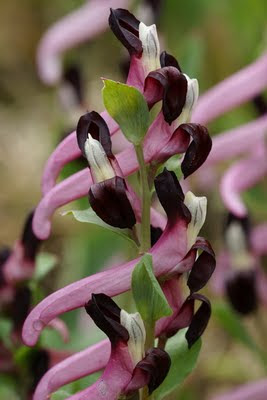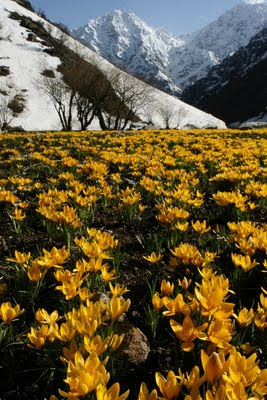We’ve been fortunate to see many wild hardy orchids around the world especially in Europe and Asia and standout examples would be fields of Orchis palustris in eastern Turkey, Ophrys-rich limestone in southern Greece and the amazing Cypripedium of China especially Cypripedium lichiangense with its big spotted leaves and bizarre flowers. However, of equal merit yet perhaps much less well-known are the stunning orchids of Chile. What we find remarkable about these is partly the size, as they almost all possess individually large flowers, but also the curious lip protrusion and grooves that feature on most species. This is obviously an aid to pollination of some sort (usually carried out by bees or sometimes flies) and Chris's leading a trip there in December with a photographer armed with an ultra-violet camera and we expect some interesting patterns to be revealed. Also they only come in three colours – yellow, white or green which suggests a limited pollinator choice, but the photographs may reveal more. Chris expects to find at least twenty species on the trip and some species are very widespread with such tall spikes that they are easily seen along the roadsides, although others such as the decidedly odd Bipinnula apinnula require some searching. Our personal favourite is the porcelain orchid Chloraea magellanica which occurs in the southern half of the country – we’ve seen it at Reserva Nacional Siete Tazas near Curico and thriving hundreds of kilometres south in Patagonia in Parque Nacional Torres del Paine where it grew in abundance with yellow Gavilea lutea. Siete Tazas has some other great orchids too including the flamboyant Chloraea galeata.
Another good location Parque Nacional Nahuelbuta is one of the world’s special places a magnificent surviving enclave of monkey puzzle Araucaria araucana forest, the tall architectural trees festooned lichens with their understorey harbouring some choice species of orchid too, not to mention superb meadows of Chloraea volkmannii and stands of tall golden Chloraea lamellata in the surrounding area. There are many other superb plants here too with the pendant branches of Berberis linearifolia appearing as golden-orange waterfalls of flowers among the southern beech trees (our favourite shot from last years’ tour) and streamsides choked with Ourisia poepigii. The atypical Chloraea nudilabia eluded me last year due to a camera malfunction so Chris hopes to bag it this time around. What’s atypical is it lacks the protrusions found on the lips of all the other species.
Chile is a superb floral destination but it’s also a long, long country and at least a month is needed to get to grips with the flora. As such we’ll be guiding alternate tours there from now on with Greentours http://www.greentours.co.uk/ with Northern Chile and Southern Chile variants. The singular blue of Puya bertroniana is one of the northern highlights, but others include wonderful Alstroemeria, Malesherbia lirana and many cacti with big showy flowers, favourites with the Giant Hummingbirds.
Berberis linearifolia
Berberis linearifolia at Nahuelbuta
Chloraea alpina
Chloraea barbata
Bipinnula apinnula
Chloraea magellanica
Gavilea odoratissima
Puya bertroniana


















































